Crew 67 – Assigned 755th Squadron – October 14, 1943

(Photo: AFHRA)
Completed Tour
| Rank | Name | Serial # | Crew Position | Date | Status | Comments |
|---|---|---|---|---|---|---|
| 1Lt | Charles A Melton | 0742188 | Pilot | 03-Jul-44 | CT | Trsf to 12RD AAF 591 - Tour complete |
| 1Lt | John Krpan | 0750799 | Co-pilot | Jul-44 | CT | Trsf to 12RD AAF 591 |
| 1Lt | Charles C Weinum | 0812022 | Navigator | Jul-44 | CT | Trsf to 12RD AAF 591 |
| 1Lt | Seldon J King | 0688364 | Bombardier | 03-Jul-44 | CT | Trsf to 12RD AAF 591 - Tour complete |
| T/Sgt | George W Bahner | 35672317 | Radio Operator | Aug-44 | CT | Left for 8th AFRD at AAF 594 |
| T/Sgt | Vernon E Goring | 17127627 | Flight Engineer | Aug-44 | CT | Left for 8th AFRD at AAF 594 |
| S/Sgt | Robert F Maher | 17166470 | Aerial Gunner/2E | Aug-44 | CT | Left for 8th AFRD at AAF 594 |
| S/Sgt | Glenn R Matson | 17108678 | Aerial Gunner/2E | Aug-44 | CT | Left for 8th AFRD at AAF 594 |
| S/Sgt | William J Webster | 36555866 | Armorer-Gunner | Aug-44 | CT | Left for 8th AFRD at AAF 594 |
| S/Sgt | Joseph J Tomich | 39274609 | Armorer-Gunner | Aug-44 | CT | Left for 8th AFRD at AAF 594 |
Crew 67, under the leadership of 2Lt Charles Melton, trained with the group in Tonopah, NV in late 1943. They flew the southern route to England in January 1944 in their brand new Liberator that the crew named Paddlefoot. The crew would fly this aircraft on 21 missions (two of which were recalled) before their tour was completed in June 1944.
Their first mission on February 24, 1944 was a diversionary feint towards the Dutch Coast in support of “Big Week”. This was followed up by nine missions in March, including the first American raid on Berlin on March 6th. The crew also quite possibly flew the first mission of the assembly ship First Sergeant on March 24th. This is the earliest that this B-24D, a veteran of the low level Ploesti raid in August 1943, shows up on 458th formation plans.
Ten missions followed in April, and then about a two week break with no missions flown. It was normally about this time, at the half-way point during a crew’s combat tour that they were given a week’s leave at a rest home. The crew followed up their break with 10 missions in May and most completed their tour on June 4, 1944. Records show that 1Lt Charles Melton flew with his good friend Myron McNamara on the first mission on D-Day (the 458th would fly three missions on this date) as a passenger. His duty on this flight is unknown. Positioned far to the rear of the formation, it is unlikely that his ship was a deputy lead in the last flight. His crew is listed as a “Spare” on this date, and since they were not needed, it appears that Melton simply hitched a ride with McNamara to get in on the “Big Show”. Several 458th men whose tours had been recently completed found ways to board aircraft to see the invasion first hand.
Missions
| Date | Target | 458th Msn | Pilot Msn | Serial | RCL | Sqdn | A/C Msn | A/C Name | Comments | |
|---|---|---|---|---|---|---|---|---|---|---|
| 24-Feb-44 | DUTCH COAST | D1 | -- | 41-28719 | -- | J3 | D1 | PADDLEFOOT | Diversion Mission | |
| 02-Mar-44 | FRANKFURT | 1 | 1 | 41-28719 | Q | J3 | 1 | PADDLEFOOT | ||
| 03-Mar-44 | BERLIN | 2 | 2 | 41-28719 | -- | J3 | 2 | PADDLEFOOT | ||
| 06-Mar-44 | BERLIN/GENSHAGEN | 4 | 3 | 41-28719 | Q | J3 | 3 | PADDLEFOOT | ||
| 15-Mar-44 | BRUNSWICK | 7 | 4 | 41-28719 | Q | J3 | 5 | PADDLEFOOT | ||
| 18-Mar-44 | FRIEDRICHSHAFEN | 9 | 5 | 41-28719 | Q | J3 | 6 | PADDLEFOOT | ||
| 23-Mar-44 | OSNABRUCK | 12 | 6 | 42-52423 | R | J3 | 4 | UNKNOWN 031 | ||
| 24-Mar-44 | ST. DIZIER | 13 | -- | 42-40127 | -- | -- | -- | FIRST SERGEANT | ASSEMBLY SHIP | |
| 26-Mar-44 | BONNIERES | 14 | 7 | 41-28719 | Q | J3 | 7 | PADDLEFOOT | ||
| 27-Mar-44 | BIARRITZ | 15 | 8 | 41-28719 | J3 | 8 | PADDLEFOOT | |||
| 05-Apr-44 | ST. POL-SIRACOURT | 16 | 9 | 41-29276 | T | J4 | 3 | URGIN VIRGIN/The ROTTEN SOCK | ||
| 08-Apr-44 | BRUNSWICK/WAGGUM | 17 | 10 | 41-28719 | Q | J3 | 9 | PADDLEFOOT | ||
| 12-Apr-44 | OSCHERSLEBEN | REC | -- | 41-28719 | Q | J3 | -- | PADDLEFOOT | RECALL | |
| 13-Apr-44 | LECHFELD A/F | 21 | 11 | 41-29359 | J | J3 | 13 | TAIL WIND | ||
| 18-Apr-44 | BRANDENBURG | 22 | 12 | 41-28719 | Q | J3 | 13 | PADDLEFOOT | ||
| 19-Apr-44 | PADERBORN A/F | 23 | 13 | 42-100365 | B | 7V | 13 | WOLFGANG | ||
| 24-Apr-44 | LEIPHEIM A/F | 26 | 14 | 41-28719 | Q | J3 | 15 | PADDLEFOOT | ||
| 25-Apr-44 | MANNHEIM A/F | 27 | 15 | 41-28719 | Q | J3 | 16 | PADDLEFOOT | ||
| 27-Apr-44 | BONNIERES | 29 | 16 | 41-28719 | Q | J3 | 18 | PADDLEFOOT | ||
| 27-Apr-44 | BLAINVILLE-SUR-L'EAU M/Y | 30 | 17 | 41-29305 | N | Z5 | 15 | I'LL BE BACK/HYPOCHONDRIAC | ||
| 10-May-44 | DIEPHOLZ | REC | -- | 41-28719 | Q | J3 | -- | PADDLEFOOT | RECALL BEFORE EC | |
| 11-May-44 | EPINAL | 39 | 18 | 41-28719 | Q | J3 | 22 | PADDLEFOOT | M/F | |
| 12-May-44 | BOHLEN | 40 | 19 | 41-28719 | Q | J3 | 23 | PADDLEFOOT | ||
| 19-May-44 | BRUNSWICK | 42 | 20 | 41-28719 | Q | J3 | 25 | PADDLEFOOT | ||
| 20-May-44 | RHEIMS A/D | 43 | 21 | 42-95159 | P | J3 | 3 | ROUGH RIDERS II | ||
| 23-May-44 | BOURGES | 45 | 22 | 41-28719 | Q | J3 | 26 | PADDLEFOOT | ||
| 24-May-44 | VILLEROCHE, near MELUN | 46 | 23 | 41-28719 | Q | J3 | 27 | PADDLEFOOT | ||
| 25-May-44 | MULHOUSE M/Y | 47 | 24 | 42-95159 | P | J3 | 7 | ROUGH RIDERS II | ||
| 29-May-44 | TUTOW A/F | 50 | 25 | 42-95316 | N | J3 | 7 | PRINCESS PAT | ||
| 30-May-44 | ZWISCHENAHN A/F | 51 | 26 | 42-50320 | W | J3 | 18 | UNKNOWN 018 | ||
| 31-May-44 | BERTRIX | 52 | 27 | 42-95008 | R | J3 | 9 | UNKNOWN 035 | ||
| 02-Jun-44 | STELLA/PLAGE | 53 | 28 | 42-95316 | N | J3 | 10 | PRINCESS PAT | ||
| 04-Jun-44 | BOURGES A/F | 54 | 29 | 41-28719 | Q | J3 | 29 | PADDLEFOOT | ||
| 06-Jun-44 | COASTAL AREAS | 56 | -- | -- | -- | -- | -- | MSN #1 SPARE CREW | ||
| 06-Jun-44 | COASTAL AREAS | 56 | 30 | 42-110184 | F | J3 | 2 | GWEN | MSN #1 - Pilot McNamara | |
| 23-Jun-44 | 3 NO BALLS | 76 | 31 | 41-28735 | V | J3 | 26 | UNKNOWN 005 | TGT #7 BLAUGERMONT | |
| 08-Jul-44 | ANIZY, FRANCE | 87 | MSHL | -- | -- | -- | -- | MARSHALING CHIEF | ||
| 16-Jul-44 | SAARBRUCKEN | 91 | MSHL | -- | -- | -- | -- | MARSHALING CHIEF |
May 1944

(Photo: Patrick Cook)
Charles Melton Memorabilia
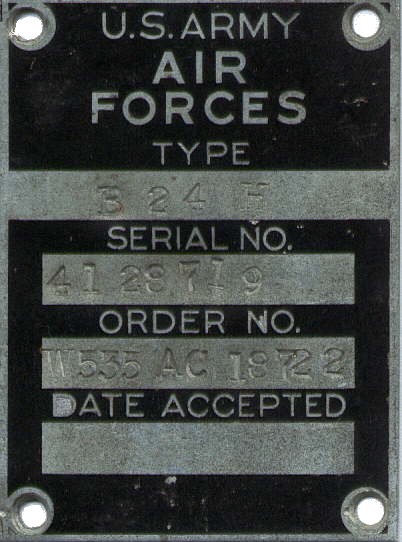


Data plate, Keys, and the No. 1 engine feather button from Paddlefoot
(Courtesy: Dave Melton)
B24H-10-DT 41-28719 J3 Q Paddlefoot
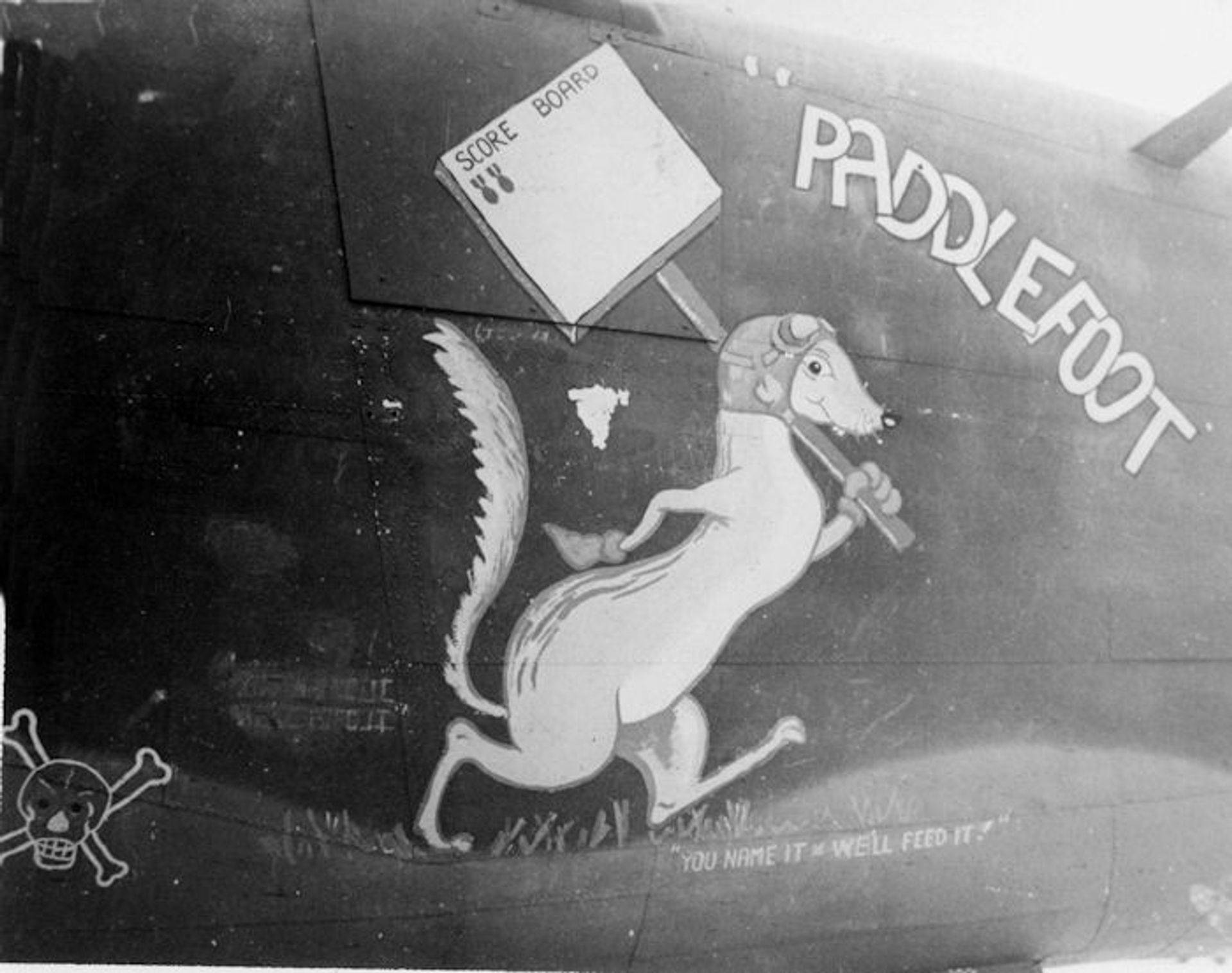

Paddlefoot showing 2 missions (left) and 36 missions (right) in mid-June 1944.
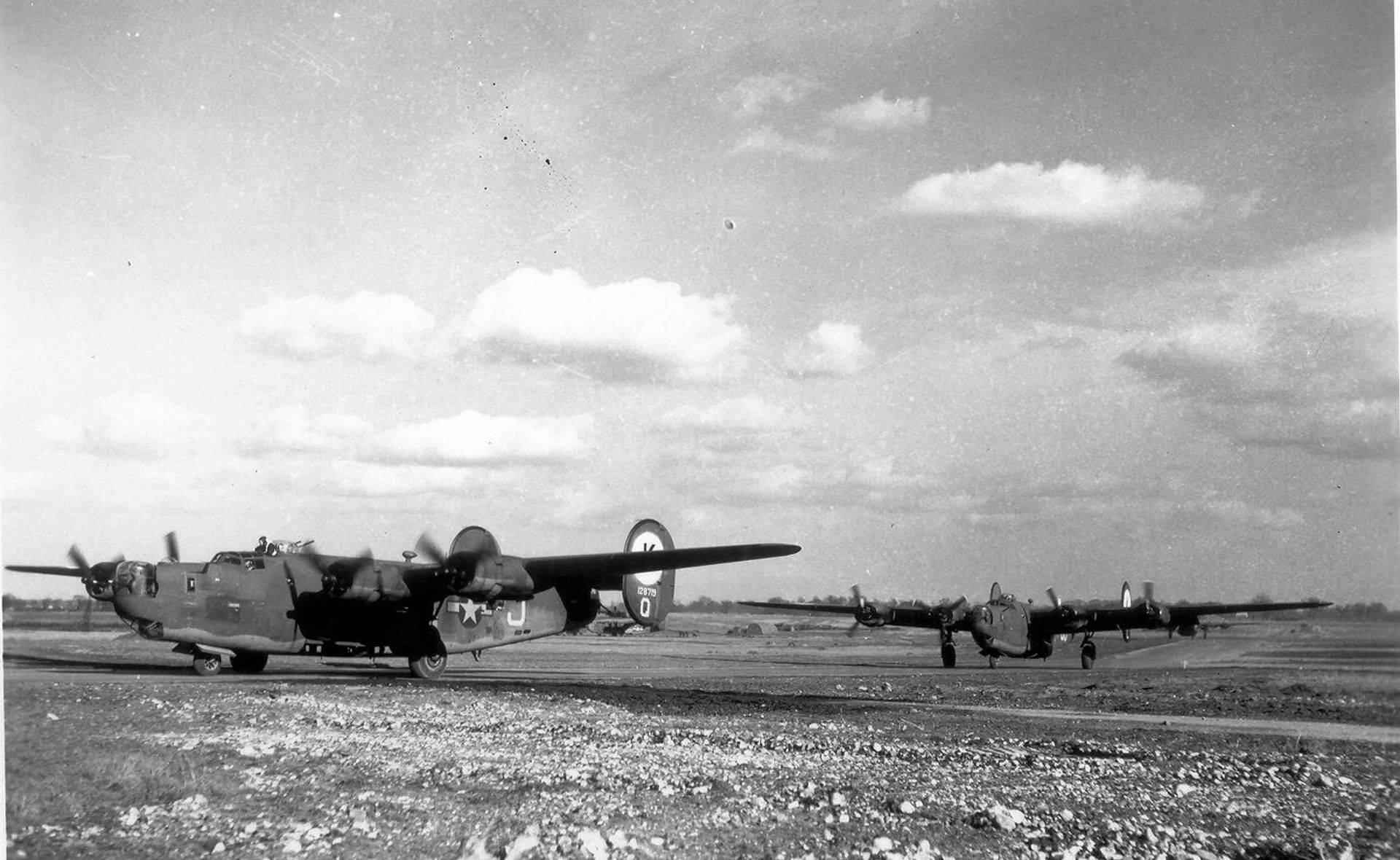
Taxiing at Horsham, spring 1944. Notice fresh tail markings and partial squadron code “J3”
(Photos: George Reynolds & Andy Gulick)
March 18th, 1944
The crew made mission #4 to Friedrichshafen, Germany. He writes It was the longest one we have made yet. We stopped some flak on the way back. A piece cut my ammo track in half (I have it hanging on the wall in my man cave, dad had saved it and mounted it on a plaque) just about three feet behind me. We Made a crash landing. A tire blown out by flak, right gear. We landed and didn’t know it was flat. As soon as we touched down, the air craft veered to the right and we went off the runway out into the grass. As soon as the aircraft started on its rampage, Sgt. Joe Tomich jumped out of the right waist window with his parachute.
As soon as the ship stopped, Willi and Red jumped on top and over me and made a head long dive out the right waist window. We all hi balled it for the open field. Thought it would blow up next. We counted heads as they came out of the ship, we were one short. Then we saw Joe walking down the runway with his chute I his hands. Webster got a hunk of flak in his heater suit rheostat, right under his seat.
(Apparently they suffered enough damage to have the plane laid up a number of days. On the 19th he said they had a tire on the bird but the left Tokyo tank got hit by flak. They had about 10 holes. On the 20th, 21st, 22nd they had some down time and went to London, got drunk and chased girls. On the 23rd he says) they went on mission #5 to Osnabruck. Slept all day on the 24th, painted some bombs on our score board. I took some pictures of flak and our formations. (didn’t quite understand that last line?) On the 25th It is a beautiful day today. Lt Melton test hopped Paddlefoot. I made my self a flak helmet (which I still have), its OK. They had a dance tonight. Got cleaned up and went to the dance, didn’t like it , came back.
(Courtesy: Gregory Matson)
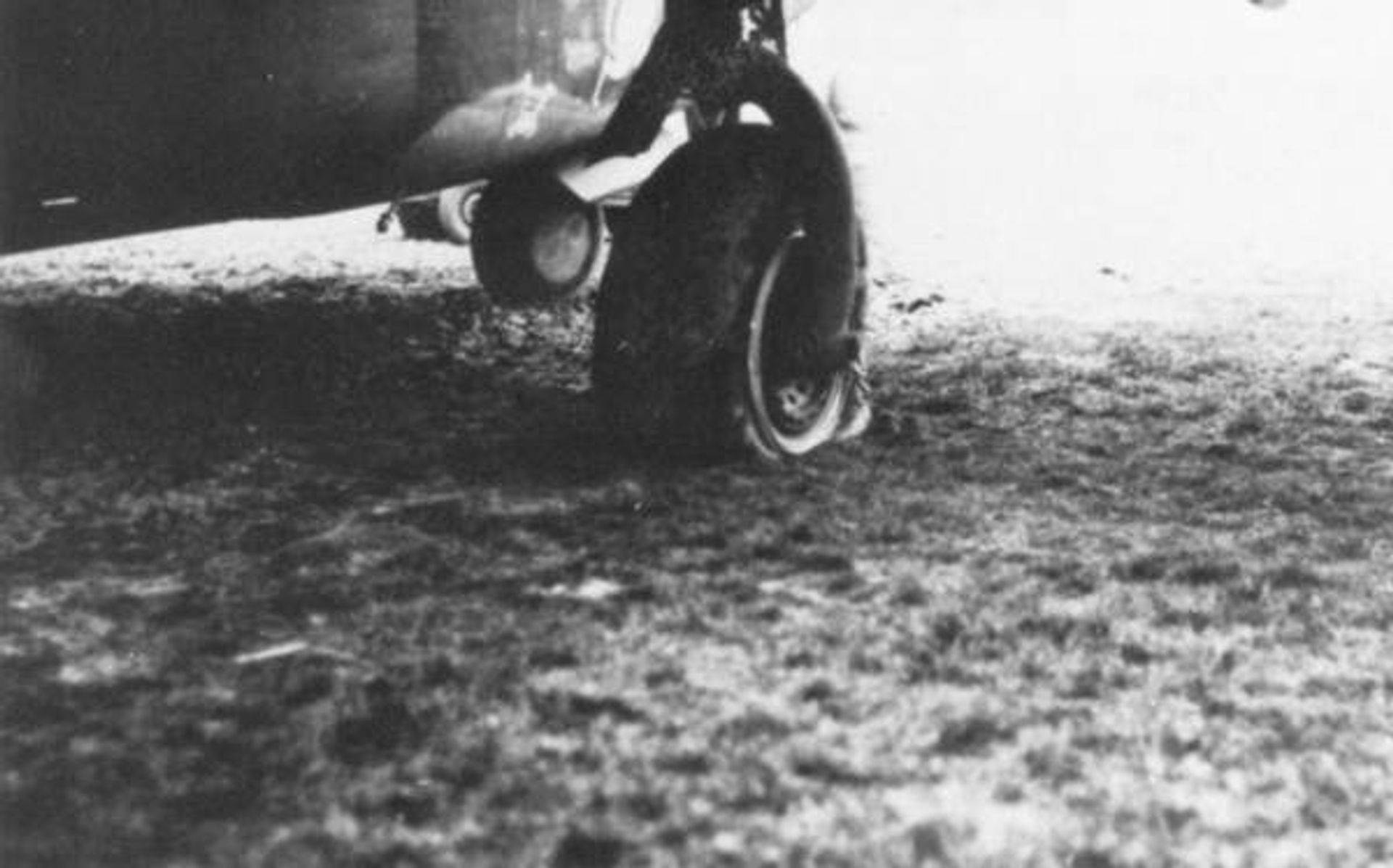
S/Sgt Glenn R. Matson
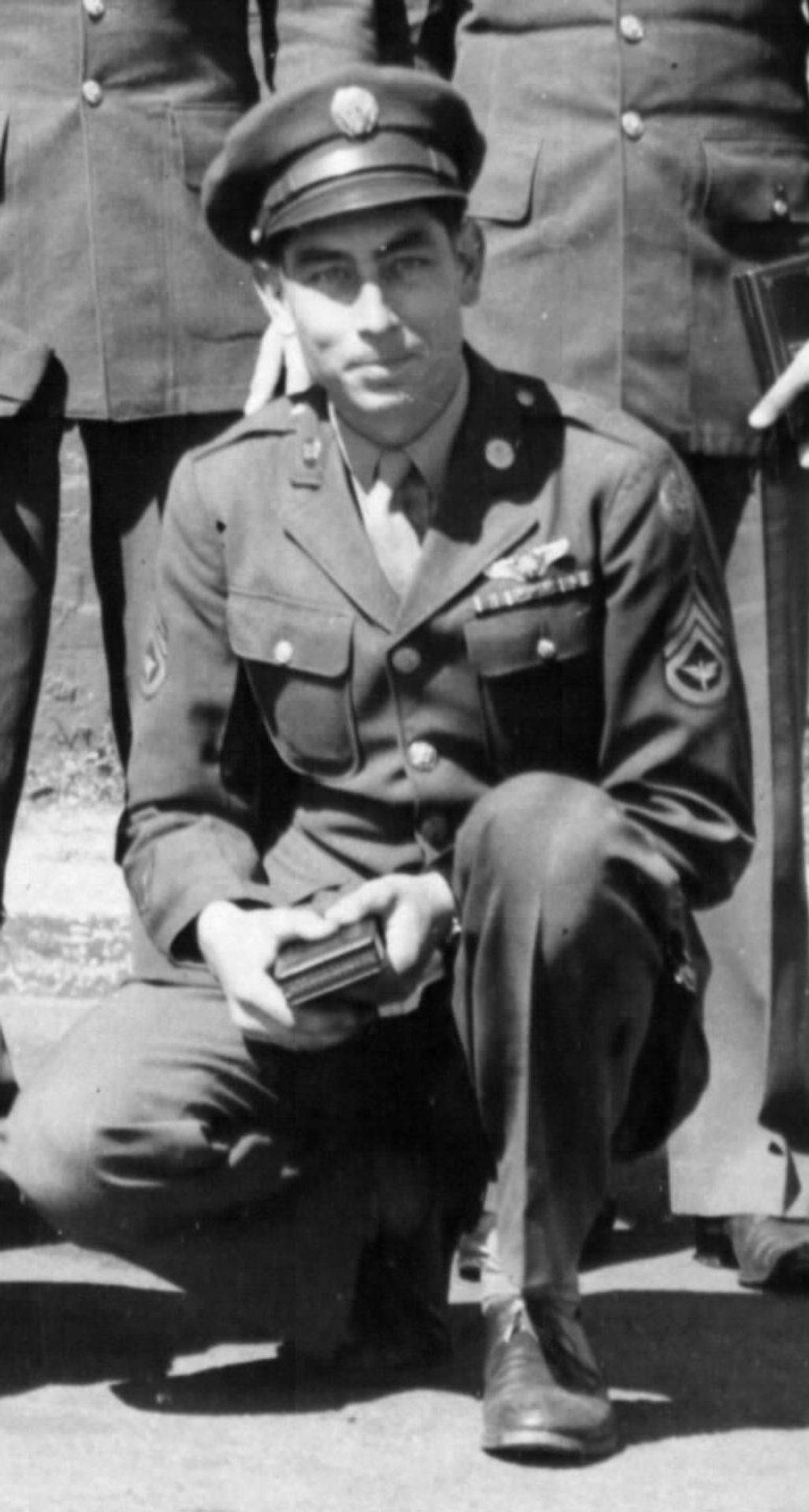
Glenn Matson, the crew’s tail turret gunner, penned several stories for the 2nd Air Division Journal. Two of them appear below.
Also by Glen Matson, see Misson 250 – Big-B under the “Personnel-Stories” page
———————————————————————————————
Combat Was Never Like This
We arrived at Horsham St. Faith, England 6 Feb 1944 with the original 458th Bomb Group, 755th Bomb Squadron. We flew our B-24 “Paddlefoot” from the States via the Southern Route. Lt Charles Melton was our pilot.
Our first mission was to Berlin, Germany 3 March 1944. We all completed our 30 missions and no one was hurt. We had the typical problems as everyone else. Flak, fighters, bad weather, low fuel on return trips, engine failures and so forth, but nothing to be alarmed about.
The day came we were all waiting for. We had completed our tour in the ETO. Now the question was what to do with retired combat crews. You can’t let them sit around with nothing to occupy their minds, so put them to work. Find them a job.
I was assigned to the Ordinance section to help load bombs and work in the bomb dump. My first job was to load B-24’s with 500 pound bombs for a mission.
We worked our tails off all night long and had the planes loaded and ready to go. Then someone said, “The mission has been scrubbed. Off load the bombs.” I thought, “Oh no! Not after all that work.”
The Sgt in charge said, “OK men, put the biscuits under her.” “Now what!” I said. He replied to put these pillow-like mattresses under the aircraft bomb bay, then set the bomb release on salvo and drop them. “You have to be out of your mind,“ I said. He said, “We do it like this all the time, it speeds up loading time.” “Yeah, and makes your trip to heaven faster too.”
Knowing I am still in my right mind, I said “So long, I want to be miles away from here when you drop these bombs.” My next stop was to see Lt. Fist, the Ordinance Officer. With my verbal resignation I told him I will fly another combat tour before I load any more bombs on B-24’s. It is too dangerous a job for me.
English Weather Was Our Enemy
2ADA Journal June 1980 Vol 19 No 2
It was just an airfield at Bourges, France (target map at right) on our 28th mission, 4 June 1944. Everything went as planned, take off OK, assembly and flight good. No flak or fighters to speak of. We dropped our 200 frag bombs and headed back to England.
Our troubles began as soon as we hit the English coast. We ran smack into a fog bank that covered the entire island. We could no longer fly formation when we hit the overcast, so we split up. Each aircraft was at its own discretion to find their way back to the home base.
Our pilots couldn’t see a thing in the overcast, so they elected to go down to 300 feet, and possibly have better visibility. This was a little better, except we were flying in the land where they grew thousands of barrage balloons. Also, England had some pretty high hills. Our nose gunner, S/Sgt Joe Tomich was the pilot’s eyes. Joe would call out the hills and obstructions ahead of us. It went like this for over an hour as we listened in on the inter-phone. “Pull up just a little Pappy. Looks good, better pull up about ten feet. OK hold it. Come down slowly… That’s good. It is getting thicker Pappy, I can’t see too far ahead. Wow! That was close. Pappy, maybe you had better get up higher, I can’t see a thing anymore.” Lt. Melton agreed, so he proceeded to climb to 14,000 feet. On the way up it was almost solid. We held our breath and caged our eyeballs.
Red, T/Sgt Vernon E. Goring and I were standing by the right waist window, when out of the fog came this B-24 from our right side. We were on a collision course. I thought, Oh my God!, we are going to collide. In seconds it was all over with. The B-24 went right over the top of us, so close I could have spit on it. Red called our pilot and told him what had happened. No one up front had seen it.
The crew was ordered to get ready to bail out. Lt Vogel in another B-24 had cracked up on the runway, and they had to move it before anyone else could land. The ground controller told everyone to hold their pattern. What pattern, there was none. No one knew where anyone was. Lt. Melton told them we can’t stay up here for long. We are running low on fuel and may have to abandon ship, if we don’t collide with another aircraft first.
He called our radio operator, T/Sgt George Bahner and told him to start shooting flares. No one told George what color, so the first one was red. When that flare went off it reflected from the clouds and fog. It appeared as an explosion to me. I immediately assumed the aircraft was on fire. I just knew we had had it now for sure. Fear told me to get the hell out. I started to climb out the right waist window. Red was standing by my side and grabbed my chute harness and pulled me back. The he told me what had happened.
At last we received instructions to land. It was raining and the runway was wet. We came in a little hot and as Lt. Melton applied the brakes we started to skid sideways, then went the opposite direction. The plane was snaking and sliding down the runway. We flashed by Lt. Vogel’s disabled plane as our pilot got ours under control. We taxied off the runway and parked it. What an alleviation to be back on the ground.
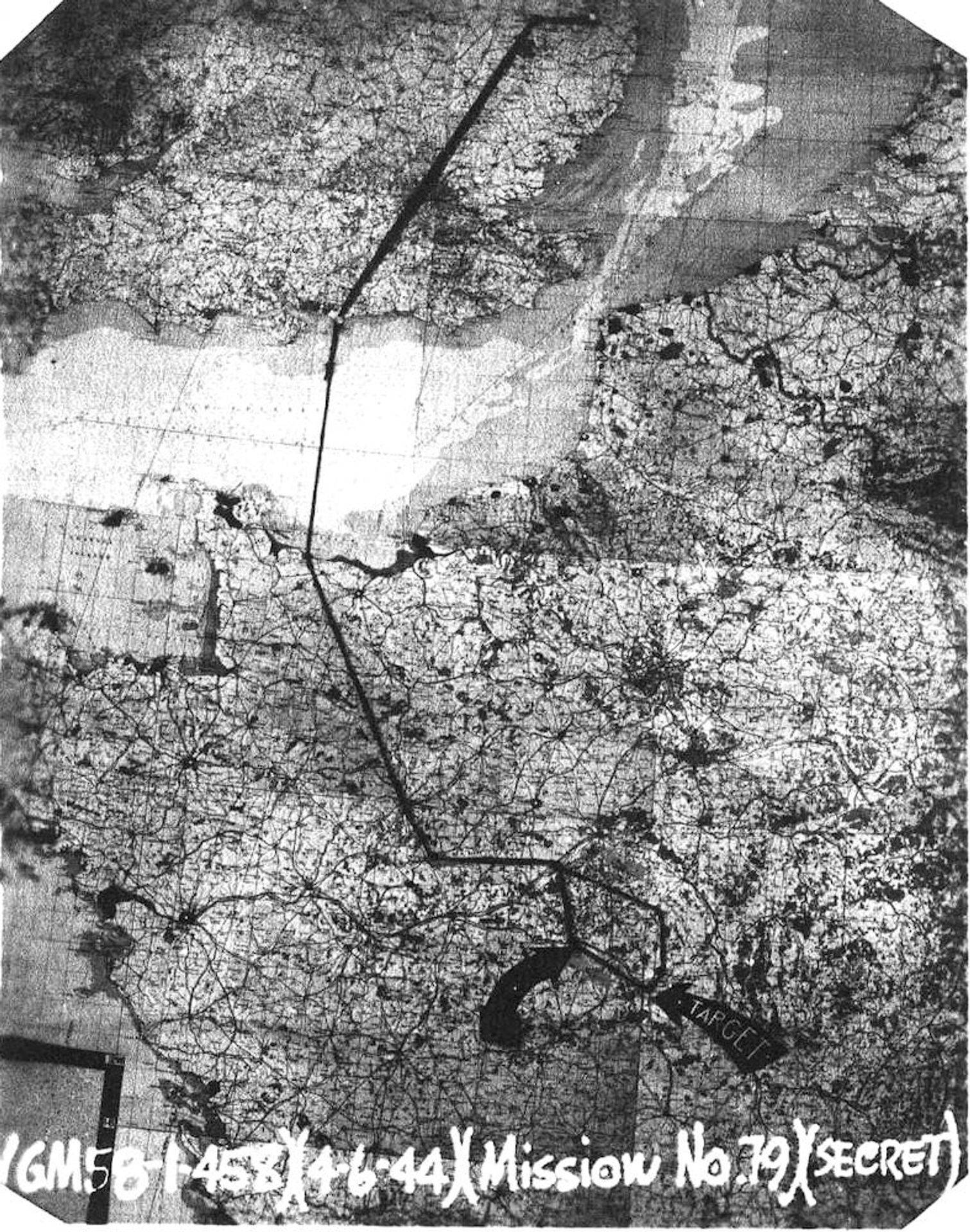
We had a replacement gunner for S/Sgt Willie Webster who had completed his 30 missions. This was also our upper turret gunner’s 30th mission, S/Sgt Robert Maher. The rest of us had [two] more to go, except the replacement gunner, he had 29 more. I can’t forget him, it was his first mission and he was flying with a veteran crew. All during this ordeal, he didn’t say a word, just stared and watched us. When we got on the ground, he said, “I thought the enemy was in Germany, but it’s not. This English weather is worse than anything I saw over France.”
In my mind, this was the most physical and demanding mission our pilots, Lt. Charles Melton and Lt. John Krpan had ever flown. Lt. Melton went on sick call immediately, and they kept him in the hospital for days. He was completely exhausted.
